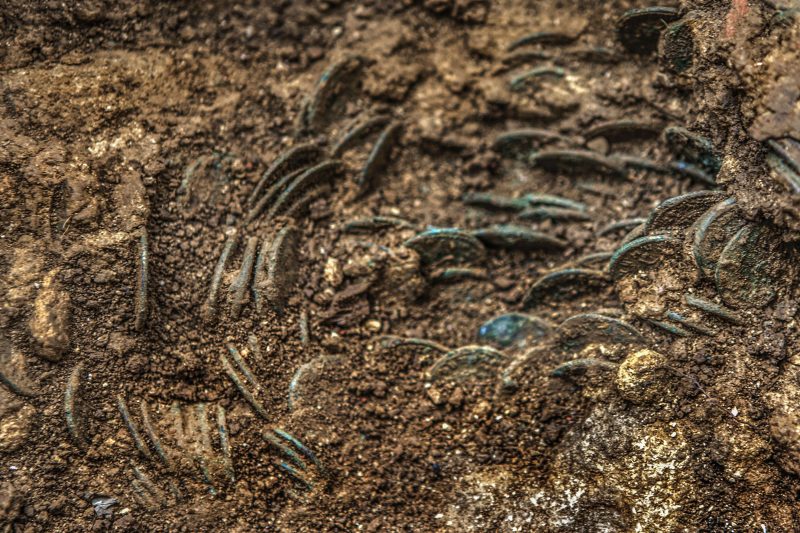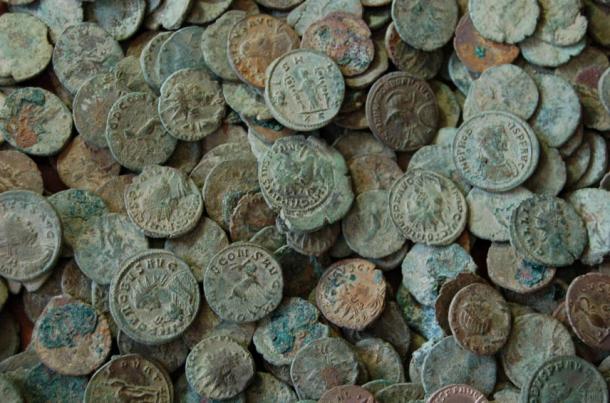In July, 2015 a Swiss farmer was inspecting his cherry orchard and noticed a strange mound of earth near the roots of one of his cherry trees. Remembering that an ancient Roman settlement had been found nearby in Frick, a small town in the Ueken region of the northern canton of Aargau, the farmer decided to investigate; to his astonishment, he saw green coins mixed with the earth. Leaving them where they were, he contacted the regional archaeological service who excavated the site, eventually uncovering 4,166 coins. The farmer who owned the field would not be allowed to keep the treasure as, according to Swiss law, it belongs to the public, but he would be paid a finder’s fee.
Some of the coins had markings indicating they were minted during the reign of the Emperor Aurelian in 274 AD, while others date from the time of Emperor Maximilian in 294 AD. This mixture of coins and the fantastic condition of the pieces, even after being buried for some 1,700 years, hint that the original owner of the cache buried them very soon after they were minted. The coins were carefully wrapped in leather bags before being buried. It is strange to think that the coins were buried so soon after being produced, but one possible explanation was that the area was experiencing runaway inflation at the time and the owner might have thought to hold onto the coins as they might gain in value. Though they were made of bronze, they contained a high percentage of silver. Inflation is also the reason archaeologists are unable to indicate what the coins would have been worth at the time, but the size of the cache indicates that this could well have been more and a year’s earnings.
The fact that someone decided to bury his coins instead of spending them is interesting in light of the policies in effect during that time. Inflation has been the downfall of many nations and it contributed significantly to the downfall of the Roman nation as well. It is not possible to simply assess monetary policy in any state; one must also consider all related factors such as security and economic issues as well. Financial policies always serve the requirements of the rulers of any nation, even if that policy is seriously flawed. These policies should also augment the lives and financial futures of ordinary people, but the major aim of any government’s fiscal policies is the needs of those in power, not those serving.
In 211 AD Caracalla came to power upon the death of his father. His father was rumored to have said, on his death bed, “live in harmony; enrich the troops; ignore everyone else”. Except for the first part (Caracalla murdered his brother, Geta), this was taken to heart by Caracalla and he increased the pay of Roman soldiers by 50%, paying for it by doubling some of the taxes paid by ordinary Romans. When he ran out of money he changed the status of every inhabitant of the Roman Empire; instead of Roman citizenship being a privilege, it became a means of levying taxes on more and more people.

When this also came up short for his needs, he debased the Roman denarius, though he was not the first to do so. This coin was made the basis of the Roman monetary system by Augustus at the end of the 1st century, and it contained 95% silver. Trajan in 117AD reduced the silver content to 85%, Marcus Aurelius brought it down to 75%, Septimus further trimmed the silver content to 60%, and Caracalla decided to make it a simple 50%. Starting with Caracalla’s assassination there came a time of immense upheaval in terms of Roman rule, with almost all of the next 26 rulers being assassinated. By 268 AD the denarius contained only 0.5% silver.
Caracalla also tampered with gold coinage. Before he came to power 45 gold coins equalled a pound of gold, but Caracalla lowered the gold content, resulting in 50 coins weighing a pound. Within 20 years of his death the gold in the coins had been so reduced that now 72 coins were needed for a pound of gold. Inflation was creeping up on the Roman people. Prices rose over 1000% and the only people paid in gold were mercenaries employed to protect the emperors.
The emperor Diocletian tried in 284 to rescue the currency and stem the inflation. He increased the gold content of the aureus so that now 60 weighed a pound, up from the old 72. Several years later he tried to abandon silver coins, which by this time were simply a bronze coin dipped in silver, and he tried to recall the denarius and issue a new coin, the argenteus, at 96 coins to the pound. The argenteus was equal to 50 denarii, but in less than ten years the argenteus was worth 100 denarii so, despite the best efforts of Diocletian and his successors, inflation was 100%.
Counterfeit coins also started to emerge and this posed a huge problem for Roman emperors. The coins were so debased that people started to manufacture their own! All of this meant that Roman coins became worth next to nothing and each time the value of silver in the coins dropped, prices tended to rise, as the coins were effectively worth less. The salaries paid to soldiers and government officials pushed prices ever higher; eventually the emperors demanded that taxes be paid in kind or by the supply of services rather than in coins. This meant that if you had a flour mill you had to supply flour to the government, if you had a factory making clothes then you made clothes for the army, and if you had trading ships you carried goods for the government. This caused the value of the coins to not only drop but completely submerge, as it appeared that not even the government wanted their own coins.
Emperor Constantine slowly but surely began to turn the tide of this horrendous situation in 312 AD. He issued a new gold coin, the solidus, and as it was solid gold, 72 weighed a pound. There was little or no gold in Rome at the time so he raised new taxes that had to be paid in gold; any state that had fallen under Roman rule and still had gold in its coffers was forced to give up that gold to Rome. Constantine had produced sufficient gold coins that the problems were lessened to a degree, but the silver coins in circulation were still a significant problem. The government in Rome seemed not to understand that management of money meant managing all the denominations, and they failed to manage the silver coins in circulation.
Cities were permitted to mint their own coins, and when they could not pay their salary bill they simply made more coins and tried to solve the problem that way. This resulted in inflation running out of control for ordinary people. The very wealthy and to some extent the army were protected as they had gold coins, which were tightly controlled and thus maintained their value. When taxes came due, people had to buy gold coins with their increasingly valueless silver coins, and when they could no longer afford to do so they would simply abandon their land or property. This again posed problems for the administration, as they had an army that was steadily increasing in size versus a steadily dwindling tax base with which to pay them. The army numbered some 250,000 in the time of Augustus and by the time Diocletian was in power the army stood at 600,000.

In addition to this, the bureaucracy had grown to alarming proportions, which made the situation worse. No amount of laws or coercion was working; the backbone of any economy, the hard working middle class, was taking the brunt of the appalling financial situation. Everyone from peasants to the upper middle class was tied up in a myriad of laws that bound them and their families to the professions or land that they originally had. This resulted in massive evasion of taxes as people left their homes, abandoned their social status, and tried to start again in a province that had a lower cost of living. People moved toward provinces like Egypt and Palestine, or if possible outside the empire – no easy task. A popular saying at the time was that people preferred to be captured by barbarians rather than live under the rule of the Roman bureaucracy.
Diocletian issued an edict where he fixed the price of goods at a standard price for that product across the entire empire and the penalty for charging more was death! Outlying provinces hardly applied the rule but in Rome it caused utter chaos. Goods vanished from the shelves as the standard price was way below the market price and there were riots in the streets. This chaos and loss of freedom for the Roman people, with the exception of the army and the bureaucracy, undoubtedly contributed to the ultimate fall of Rome. People preferred to live under someone else’s rule rather than that of Rome, and slowly but surely the empire was dismantled.
With this chaos around him, it is not surprising that our Roman citizen chose to bury his coins; at that time 5% silver in a coin was a rarity indeed. He would have had no idea what would be lying in wait for him around the corner, or what amount of inflation he would be subjected to.

